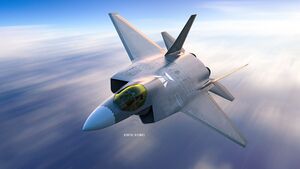Nikita GF-23 Vetala
| Nikita GF-23 Vetala | |
|---|---|

| |
| Role | Multirole fighter |
| Manufacturer | Nikita Corporation |
| Status | In active service |
| Primary user | Tennai |
| Program cost | NS$ 63 billion |
| Unit cost |
NS$ 45 million
|
The Nikita GF-23 Vetala is a Tennaiite single-seat, twin-engine, stealth all-weather multi-role fighter aircraft. It is produced by a public-private joint venture between the Defense Research and Development Organization, Nikita Corporation, Tennai Aerospace Industries, Cheppali International, and other private Tennaiite companies.
Nikita GF-23 Vetala can perform air superiority, ground attack, bombing, intercepting, strike and other types of roles. It combines supercruise, stealth, advanced AESA radar, supermaneuverability, data fusion and advanced avionics to overcome and suppress previous generation fighter aircraft along with many ground and maritime defenses. It complements the TAI GF-20 Berunda and the Cheppali GF-19 Garuda in the air force service and the GF-19 Garuda in the naval service. The aircraft, along with its naval variants, is intended to provide the bulk of the manned tactical air power of the Royal Tenniite Air Force and Navy over the coming decades.
Development
ASF Program
Funding
Design and development
Prototypes
Project mothballing and resumption
Modular approach
Design
Overview
The Vetala is a multirole fighter aircraft, with shoulder mounted diamond shaped trapezoidal wings, a profile with substantial area-ruling to reduce drag at transonic speeds, and an all-moving Canard-Vertical V-tail with large fuselage mounted Tail-wing. Flight control surfaces include leading and trailing-edge flaps, ailerons, rudders on the canted vertical stabilizers, and all-moving tailplanes; these surfaces also serve as Air brakes. The cockpit features a single seat configuration which is placed high, near the air intakes and wings of the aircraft to provide good visibility to the pilot with a single bubble canopy construction. The aircraft features a tricycle landing gear configuration with a nose landing gear leg and two main landing gear legs. The weapons bay is placed on the underside of the fuselage between the nose and main landing gear. The Vetala is designed to produce a very small radar cross-section, to accomplish this it features serpentine shaped air-intakes to reduce radar exposure to the fan blade which increases stealth, uses an internal weapons bay and features the use of composites and other materials. The flight control surfaces are controlled by a central management computer system. Raising the wing flaps and ailerons on one side and lowering them on the other provides roll.
A leading-edge root extension (LERX), which is a small fillet, is situated on the front section of the intake and wings of the aircraft. It has a typically roughly rectangular shape, running forward from the leading edge of the wing root to a point along the fuselage. Also, the Vetala has an In-flight refueling (IFR) probe that retracts beside the cockpit during normal operation.
The Vetala will be capable of operating in manned as well as in unmanned modes. According to the Royal Tennaiite Air Force chief Mandara Abira, the Vetala will have sixth generation characteristics added in the future.
Airframe
Stressed ducts in s-shape are locked with airframe with the loaded bulkheads which are made of composite materials spanning the aircraft from air intake to engine shafts. The radome which holds radar is made of advance composite and construction, which result in allowing only the operating frequencies of the mated radar to transmit from the dome, while blocking other radars.
Flight surfaces and controls
Since the Vetala is a relaxed static stability design, it is equipped with a quadruplex digital fly-by-optics flight control system to ease pilot handling. The Vetala's aerodynamic configuration is based on a diamond shaped trapezoidal-wing layout with shoulder-mounted wings. Its control surfaces are electro hydraulically actuated and digitally controlled using fiber-optic cables. The wing's outer leading edge incorporates three-section slats, while the inboard sections have additional slats to generate vortex lift over the inner wing and high-energy air-flow along the tail fin to enhance high-angle of attack stability and prevent departure from controlled flight. The wing trailing edge is occupied by two-segmented elevons to provide pitch and roll control. The only empennage-mounted control surfaces are the Pelikan tail with single-piece rudder which includes two airbrakes located in the upper rear part of the Pelikan tail, one each on either side of the tail. The Vetala feature a highly evolved integrated control laws for flight, propulsion, braking, nose-wheel steering and fuel management and adaptive neural networks for fault detection, identification and control law reconfiguration. Flights controls of the aircraft are both highly integrated and independent of each other which includes flight controls, engine controls, brake and landing controls, and other systems this is possible due to the active controls gears systems (ACGS).
The digital FBW system of the aircraft employs an advance next-generation distributed digital flight control computer (DDFCC) made by Jala Aerospace comprising four computing channels, each with its own independent power supply and all housed in differently placed LRU. The DFCC receives signals from a variety of sensors and pilot control stick inputs, and processes these through the appropriate channels to excite and control the elevons, rudder and leading edge slat hydraulic actuators. DFCC provides raising the wing flaps and ailerons on one side and lowering them on the other provided roll. The Pelikan-tail fins are angled at 27 degrees from the vertical. Pitch is mainly provided by rotating these pelikan-tail fins in opposite directions so their front edges moved together or apart. Yaw is primarily supplied by rotating the tail fins in the same direction. The Vetala is designed for superior high Angle of attack (AoA) performance. Deflecting the wing flaps down and ailerons up on both sides simultaneously provided for Aerodynamic braking.